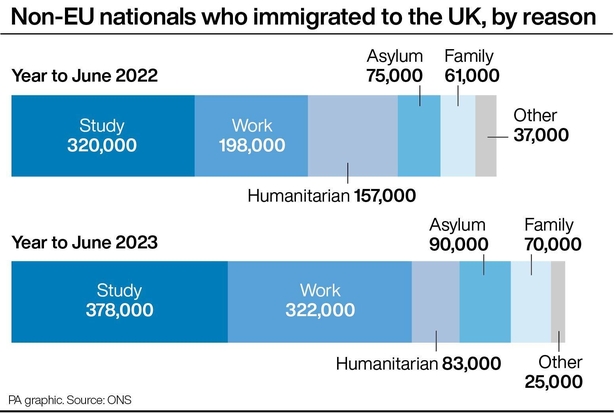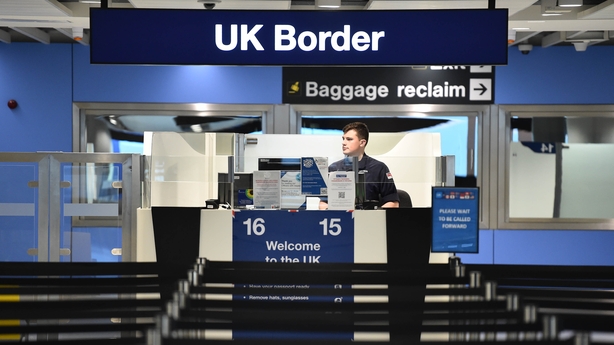Annual net migration to the UK hit a record of 745,000 last year and has stayed at elevated levels since, according to the latest figures, increasing pressure on Prime Minister Rishi Sunak to reduce it in the run up to a general election.
High levels of legal migration have for more than a decade dominated the UK's political landscape, and will be a key battleground again in the vote which is expected next year.
The data is a fresh setback for Mr Sunak, whose flagship policy to tackle illegal arrivals was all but dashed last week by a court ruling that a plan to send asylum seekers to Rwanda was unlawful.
As well as his pledge to "stop the boats", a reference to illegal migration, he has also promised to cut the number of people coming into the UK legally, responding to voter worries about the pressure on public services and housing shortages.
For the year ending December 2022, the Office of National Statistics (ONS) revised up the net migration figure to 745,000, a new record high and up 139,000 on its previous estimate.
It also said the net migration number for the year ending June 2023 was 672,000, up from 607,000 a year earlier.
The ONS said the majority of immigration was now non-EU nationals, with the increase in the year to June mainly driven by migrants coming for work, particularly to fill shortages in the health and social care sectors.
Those coming to the UK to study make up the biggest proportion of non-EU nationals, it added, with evidence showing in recent years that more students are staying for longer and moving on to work visas.
The top three non-EU nationalities for immigration in the year to June were Indian, Nigerian and Chinese, it said.

UK Home Secretary James Cleverly said the government wanted to eliminate abuse of the visa system to get numbers down.
"The government remains completely committed to reducing levels of legal migration," he said in a statement.
The high levels of migration - more than double the 329,000 figure recorded in the year before the 2016 Brexit referendum which was in part driven by concerns about migration - illustrate the challenge Mr Sunak faces given the country's labour shortages.
"This level of legal immigration is unsustainable both economically and socially. There is no public mandate for it, it is beyond our public services' capacity to support and it undercuts UK productivity and wages by substituting cheaper foreign labour," former Conservative Party minister Simon Clarke said on social media. "We need an urgent change of approach."

The ONS said the number of people arriving on humanitarian routes such as special schemes for people from Ukraine and Hong Kong, which have helped drive an increase in the figures over the last two years, fell during the most recent period, the 12 months to the end of June.
While the UK government may try to cast the fall from 745,000 in 2022 to 672,000 as evidence its policies to reduce numbers were starting to work, the ONS said it was not yet clear whether the figure had peaked.
The opposition Labour Party's home affairs spokesperson Yvette Cooper said the figures show the government has "no grip on immigration and asylum and no plan for the economy".

These provisional figures show that net migration to the UK continued to increase massively in recent years despite promises made during the Brexit campaign and by successive Conservative Party governments to reduce the number.
Immigration from EU countries has fallen sharply, but this has been more than made up by immigration from non-EU countries, particularly India and Nigeria.
The growth in the number of student arrivals has also been a noticeable trend.
The ONS says the revision of its net migration estimate for the year to December 2022 - a record 745,000 - is due to more travel data and in particular estimates of whether non-EU immigrants are staying long term.
Net migration for the year to June 2023 of 672,000 indicates a slowing down, according to the ONS.
But it is still double the 336,000 net migration figure in the year before the 2016 Brexit vote.
As the ONS states: "Each year hundreds of thousands of people immigrate to the UK long term for a variety of reasons, for example, for work, study, family or humanitarian relief.
"Depending on the reason for migration, along with other factors, some individuals are more likely than others to either remain in the UK or leave for home or another country".
The total immigration figure was 1.2 million while 508,000 emigrated.
Non-EU immigration have surpassed EU arrivals since Covid-19 travel restrictions ended in 2021.
Immigration from outside the EU accounted for 82% of arrivals - the top five countries are India (253,000), Nigeria (141,000), China (89,000), Pakistan (55,000) and Ukraine (35,000).
EU states accounted for just 11% of total immigration in this year's figures compared with 63% in 2016.
More than a quarter are from Romania and Bulgaria.
And EU nationals are leaving at a higher rate accounting for 42% of those emigrating.

Other trends include less refugees, a number that had been boosted in recent years by people coming from Ukraine and Hong Kong.
But the percentage of humanitarian arrivals is just 9% of the total, compared to 19% in June 2021.
The increase is accounted for by people arriving for work, particularly in the healthcare sector.
There has also been a huge increase in study-related visas, up from 24,000 in 2019 to 263,000 this year.
Typically most international students would emigrate after study, but increasing numbers are staying and switching to work visas.
In the academic year ending in 2022, 35% of students left the UK compared to 61% in 2020.
The issue of international student visas and how many dependents they can bring is being examined by the UK government.
But current Foreign Secretary and former prime minister David Cameron campaigned in the 2010 general election promising to get immigration down to the "tens of thousands".
This pledge was repeated by Suella Braverman when she was home secretary.
However, the numbers have in fact reached record levels.

